One of the most harmonious plants for your garden is the watermelon, which gets along well with a wide variety of crops. Most likely, this is the reason they appear in lists of companion plants.
While choosing which plants to plant next to watermelons and where to place them, there are a few factors to keep in mind, even though there aren’t any set rules for watermelon companion planting. The best plants to cultivate with watermelon this season are examined in this post!
Watermelons as Companion Plants
It’s usually a good idea to know how watermelons interact with other plants before selecting companion plants for them. Because they possess both positive and negative qualities, they are not good neighbours in every way.
Benefits
Watermelons have the ability to suppress weed growth by suffocating undesirable plants. Weeds may be an issue while the plants are young because they become really useful only after they have long vines. Nevertheless, weeding will take less time in the summer!
Additionally, the lengthy vines can stop the wind from removing all of your dirt. Watermelons are useful if the wind isn’t shielding your garden. If it rains a lot, the melons can help contain damage since their roots and vines can stop water from washing away soil.
Disadvantages
You recall that I mentioned that they might choke off undesirable plants? They can also choke out plants that you want to grow. You just need to be careful and make sure the vines don’t grow too big to intercrop. If you have rambunctious melons, companion planting may appear like plants in pots or along the borders.
Thirsty and hungry watermelons. Given that they are watermelons, you will need to give them frequent watering as well as occasional supplementary fertilizer or compost. It is important to keep in mind that plants that require frequent feeding will not thrive in the melon patch.
Companion Plants for Watermelons
1. Onions

Onions, like garlic, are wonderful allies that deter a variety of pests with their potent aroma. You can get them rather close to your watermelons without any issues, depending on the type of onion you plant.
Chives and green onions work well in between rows, but bulbing onions must be planted at the extremities of the rows, far from the roots of the watermelon. Both plants will be unhappy since the huge bulbs will obstruct the shallow watermelon roots.
2. Snapdragons
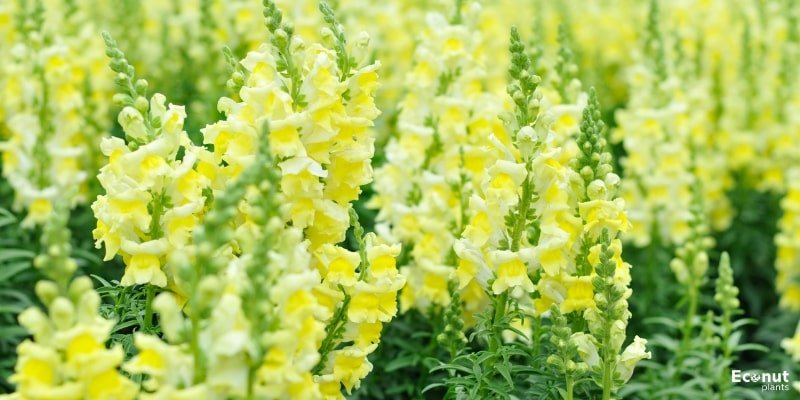
Beautiful blooms that will catch your eye are Snapdragons. You should plant pollinators next to your melons since it attracts their interest as well.
It is advisable to use these flowers on the ends of watermelon rows away from the roots to prevent competition because they can grow up to 15 inches tall and 3 feet broad. They are an excellent plant to have around because they won’t cast too much shade.
3. Radishes

Radishes are a great way to maximize the space you have available. Sow radish and watermelon seeds together so you can pick the radishes before the watermelons require room to grow. Plant them regularly next to your watermelons so they can serve as an aphid trap crop.
Select a dwarf variety, such as the Early Scarlet Globe, to avoid the risk of the root entangling the roots of the melons. Some radish cultivars are so large that they are not suitable as companions.
4. Nasturtium

There’s a good reason nasturtium is a favourite trap crop. I adore its distinctive leaves and vibrant blossoms, making it one of my personal favourites. Aphids and caterpillars will stay away from your melons if you place this pest-attracting plant next to your watermelon, despite its aesthetic appeal.
Though it’s preferable to place them in a container or at the end of rows, this flower’s compact growth habit shouldn’t impede your watermelons.
5. Garlic

Garlic is a fantastic plant to have around for pest control because of its strong aroma, which repels a lot of insects.
Watermelon rows should be able to accommodate the small garlic bulbs unless you are cultivating elephant garlic. However, avoid letting it get too close to the roots of the watermelon, as this will cause competition for nutrients and water.
6. Cilantro

Watermelons and cilantro get along well since they don’t crowd each other out or cast too much shade. It can be planted on the ends of the watermelon rows or in between them.
This fragrant annual attracts ladybirds and lacewings, among other helpful insects, especially in the flowering season. You should include this plant because these insects will consume pests like aphids and other soft-bodied insects that cause havoc on your melon crop!
7. Basil

Many people in the garden consider basil to be a buddy. Numerous pests, such as thrips, are deterred from settling on your watermelon plants by its potent aroma. To confuse insects, plant basil around the edges of your patch or in between your watermelon rows.
Basil can grow bushy and has a shallow root system. If you position your watermelons correctly, it shouldn’t have a detrimental effect on them, but if you’re worried, you can always put them in a nearby container.
8. Corn

If you’re experimenting with the Three Sisters strategy I described above, corn plant is a fantastic to include in your watermelon field. You can use it as a trellis for beans or peas, eliminating the need for you to construct trellises yourself.
In the absence of preventive measures, maize and watermelons may be more susceptible to pest pressure because they have many of the same insect issues, such as aphids and thrips. Companion planting is an excellent technique because of this, and you should also include plants that ward off these pests.
9. Lettuce

Due to its many uses, lettuce makes an excellent companion plant. Sow the seeds for both watermelon and lettuce simultaneously. Your watermelon seedlings will benefit from the lettuce’s rapid growth and ability to function as a ground cover to keep weeds out.
By the time the watermelons require room; your lettuce will be ready to harvest, so you don’t need to worry about crowding.
10. Poppies
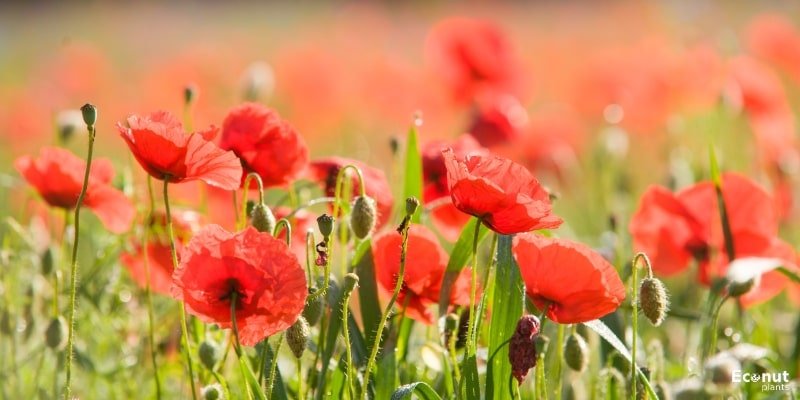
Watermelons benefit from the companionship of poppies because they are short, bushy plants that don’t provide much shade. To ensure that your melons are pollinated, you should have them around, as they draw in a lot of pollinators, such as bees and butterflies. Your garden bed will look stunning if you combine these with another suggested bloom!
11. Tansy

Tansy is a stunning flower that attracts a lot of pollinators, but gardeners tend to ignore it because it is poisonous and sometimes even classified as a noxious weed. You should be able to handle this one with gloves if you keep it in a container.
In your yard, this bloom will attract bees, butterflies, parasitic wasps, and hummingbirds. This will increase plant pollination, which will produce more watermelons.
12. Sage

Sage is among the numerous herbs that make excellent friends due to their shallow roots and ability to ward off pests. Flea beetles and cabbage loopers, which annoy your watermelon plants, can be repelled by it.
Like oregano, sage requires a lot of water; therefore, you may grow it near watermelons, as I previously mentioned. The watermelons will take the remaining water, and the sage will take what it needs.
12. Sunflowers

If you choose to follow the Three Sisters gardening method, sunflowers make an excellent substitute for maize. Sunflowers have tall, robust stalks that can support pole beans and peas with ease and keep the watermelons from being overly shaded. To lessen the chance of powdery mildew, be sure you water your sunflowers and beans from the base!
Sunflowers attract a lot of insects, which means that they attract pollinators and insect predators. An added plus is that they will give your watermelon patch a vibrant flash of colour!
14. Mint
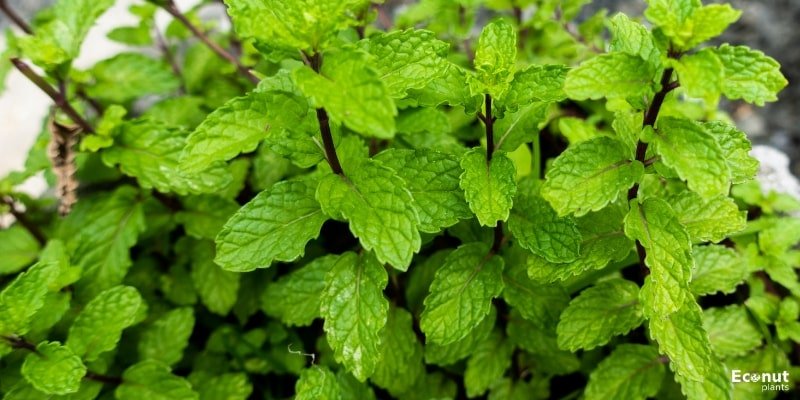
While mint repels aphids and flea beetles quite well, it must be kept under check because it grows quickly! Make sure its underground runners do not get into your watermelon bed and store it nearby in a container or elevated bed. It’s also handy to have mint on hand for dinnertime, as it tastes great in a watermelon salad.
15. Dwarf Bee Balm
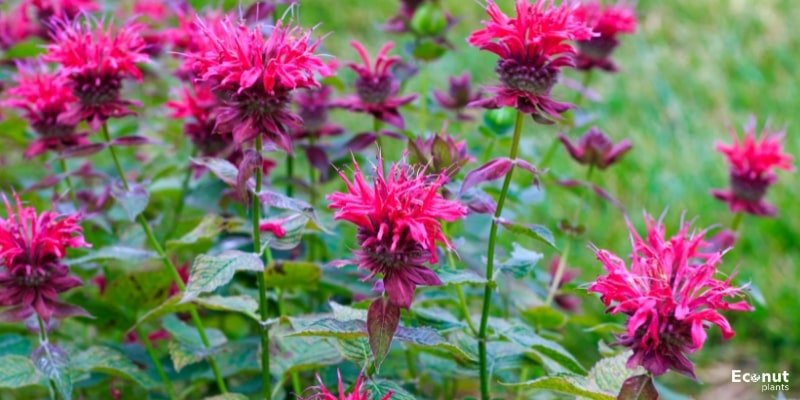
The lovely flower known as bee balm has striking, fluffy flower heads. This flower can attract a variety of helpful insects, so you might as well plant it around the yard!
The dwarf variety’s compact growth pattern makes it ideal for planting alongside watermelons. Because it won’t grow too tall and remain self-contained, overcrowding won’t be a major issue.
16. Cabbage

Cabbage is a nice companion crop to have around as a pest trap, but you won’t want it too close to your watermelons because of its size. Aphids, beetroot armyworms, thrips, flea beetles, and cabbage loopers are just a few of the insects that love a nice cabbage as much as they do watermelons.
To avoid getting in the way of the roots and vines, plant cabbage at the ends of your watermelon rows. You should notice less damage to your melon plants as a result of the insects’ large flock to the cabbage.
Whether you want to try to harvest the cabbage or give it to the animals is entirely up to you. Use any other brassica, such as broccoli, kale, or collard greens.
17. Beans and Peas
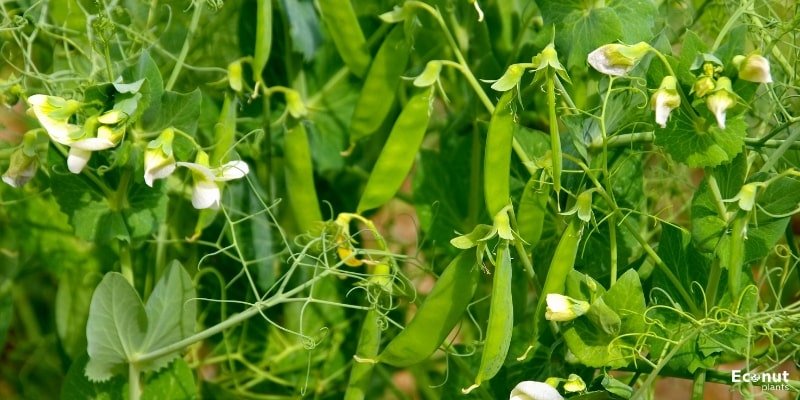
Given their nitrogen-fixing roots, bean, pea, bush, and pole types are ideal plants. When they break down, the roots of the plants take up nitrogen from the atmosphere and store it for later use. Also, because beans draw nitrogen from the air rather than competing with watermelon for the soil, they grow well next to it!
Although it may seem that vines and pole varieties don’t go together, they do. Watermelons can be used in place of squash in the Three Sisters method of agriculture, which was originally used by Native Americans.
It involves placing maize, pole beans, and squash together. Watermelons provide a ground cover, legumes supply nitrogen, and corn or sunflowers act as a natural trellis for the legumes.
18. Marigolds

Watermelons, among most other vegetables in the garden, pair well with marigolds. Squash bugs, mosquitoes, and tomato hornworms are just a few of the creatures they keep away. Along with serving as a trap crop for many pests, including aphids, they also aid in the regulation of nematode numbers in the soil.
Marigolds grow compactly, which makes them ideal for a watermelon patch. They won’t fight for space if you put them at the edges or in between rows.
19. Oregano

Oregano may spread up to eighteen inches in width and grow rapidly. Melons may not seem like a good combination, but they go great together. Though their roots are shallower than those of oregano, watermelons grow a little bit deeper.
Because the watermelons absorb the remaining water when they are planted close by, the oregano doesn’t get overwatered. It’s quite cool how they support one another!
20. Dill

Plant a few dill plants next to your watermelons since ladybirds prefer them over aphids almost exactly. Insects that feed on aphids will also swarm to it. Aphids, be careful!
Dill won’t impede the melon vines’ growth habits or cause undue competition for nutrients and water. In between watermelon rows, it functions well and shouldn’t grow too quickly to cause issues, especially if you’re harvesting from it frequently.
Conclusion
It’s not necessary to grow just watermelons in a certain spot. There’s an endless number of harmonious pairings to experiment with! Choosing a few of your favourite plants and seeing their plant friendship blossom is a smart way to garden as companion planting.

